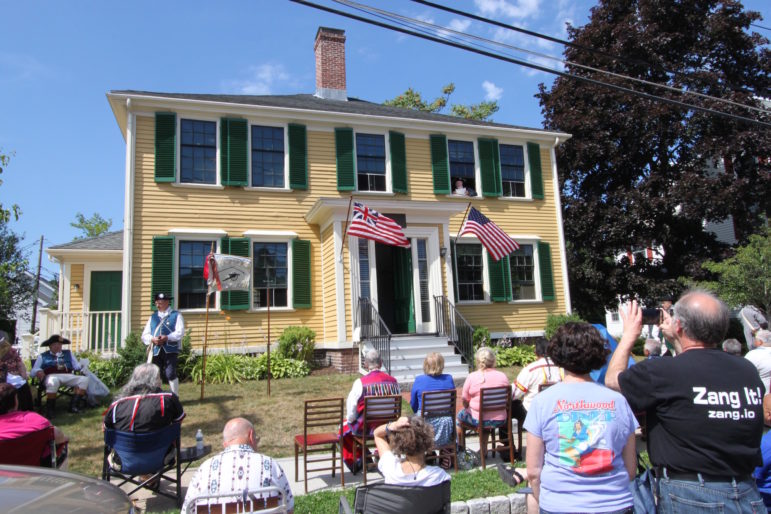
Charlie Breitrose The Edmund Fowle House has been in Watertown for 251 years, though not always at its current spot on Marshall Street. It played a role in the American Revolution, including the first reading of the Declaration of Independence in Massachusetts (re-enacted here in 2016) and was where the first treaty was signed by the United States. It is now home to the Historical Society of Watertown which is celebrating its 100th anniversary.
Living in a house dating back to the time of the American Revolution can be an adventure, with bouncy floors, water coming through the ceiling, and evidence of superstitions of times past.
Former Historical Society President Paul Brennan recalled his years spent living in the Edmund Fowle House on Saturday when he returned for the Society’s 100th anniversary and the celebration of 251 years for the home that played a role in the American Revolution. The Historical Society will host several open houses at the Edmund Fowle House over the next couple months as part of the celebration.
The Fowle House was built in 1772 and quickly became part of the newly created United States. The Provincial Congress met in Watertown days after the battles in Concord and Lexington. On July 20, 1775, the Provincial Congress elected a 28-member Executive Council (or Governor’s Council) to serve as its upper house, which served as its executive body instead of a governor. The Council Chamber, on the top floor of the house, was also the location of the signing of the Treaty of Watertown, the first treaty signed between the U.S. and a foreign power: the St. John’s and Mi’kmaq First Nations of Nova Scotia.
From the late 1980s to the early 1990s, the then 20-something Brennan was the sole occupant of the Fowle House, located on Marshall Street, just off Mt. Auburn Street. When asked what it was like living there, he responded, “Spooky.” But it was quite an experience.
“The floors would bounce like a trampoline when you were walking across them,” Brennan said.
Finding History
Brennan moved in to be a caretaker, as well as to find ways to bring more attention to the house that is headquarters for the Historical Society of Watertown.
“The only way to do that was to turn over every stone,” he said.
In his explorations he found some interesting things while poking his head into gaps in the floorboard in the attic.
“The house is so old, it makes sense to have fluctuated in use at periods of time. What we were finding up there was old newspapers, it was fascinating and you try to connect the dots,” he said. “It’s our nature to want to get answers.”
In a display case in the Fowle house sits a weathered old shoe, which Brennan recovered from the attic. The clearly comes from a bygone era, and it may have been left there purposely as a way to protect the residents of the home from evil spirits.
“The shoe was a really cool find, because of that connection to older practices, superstitions in the community,” Brennan said. “Research into the practice of shoes in the attic, it’s just fascinating.”
Charlie Breitrose
This shoe was discovered in the floor of the attic in the Fowle House by then-caretaker Paul Brennan, who was also President of the Historical Society. It can be seen on display at the house, which is now the Society’s headquarters and museum.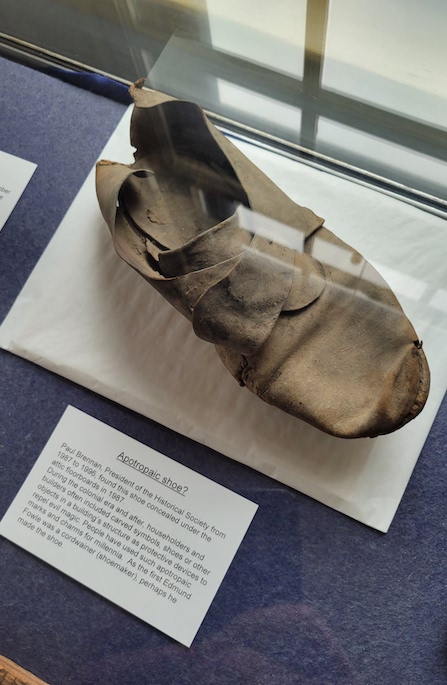
The shoe may have a direct connection to the original owners of the house, said Joyce Kelly, a member of the Historical Society’s Council.
“Edmund’s father was a cordwainer,” she said. “It’s very possible he made that shoe.”
In another exploration of the property, Brennan found a well in the backyard.
“We found a lot of stuff that was weird for this day, but for the past was an absolute necessity,” Brennan said.
Homes built before the 1870s would all have a well or cistern, Kelly said, noting that the Fowle house got water service in 1893. When Brennan looked up the home’s plumbing records, a familiar signature was on the document — Charles Brigham.
Along with John Hubbard Sturgis, Brigham purchased the Fowle House in 1871 and moved it from its original location on Mt. Auburn Street at Common Street to Marshall Street.
The new owners turned the house into a two-family home. Each side had two rooms upstairs and two rooms downstairs, which were not totally separated, Brennan said.
“Basically, they shut doors,” he said.
In 1922, Brigham sold the house to the Historical Society of Watertown for a small sum, said Marilynne Roach, President of the Historical Society.
“When (the Society) started they didn’t have a place to go,” Roach said. “People had stuff in their homes and the Library had some of the collection.”
The house is the Watertown’s second oldest remaining house, with the oldest being the Browne House on Main Street (next to the Police Station). A private home on School Street, which is similar in style to the Fowle House, is the third oldest, Roach said, and the next oldest house was turned into law offices, and sits across Main Street from the Watertown Library.
Charlie Breitrose
Current Historical Society of Watertown Council member Joyce Kelly and former President Paul Brennan spoke about the Fowle House at an open house on Sunday.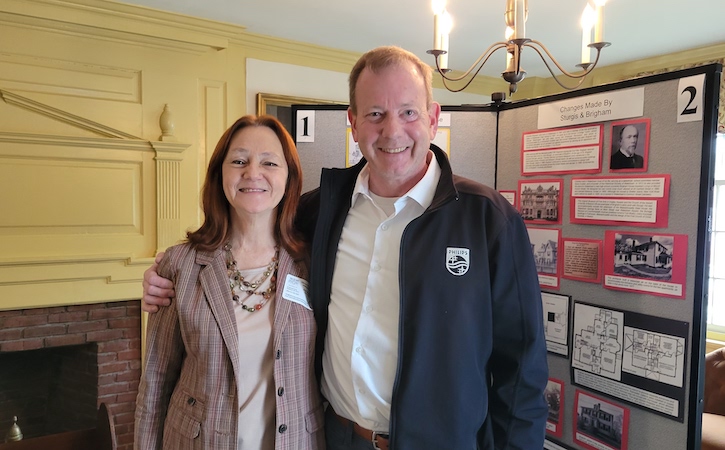
Saving the Home
The Historical Society faced an uphill battle keeping the house in working order, let alone remain standing. The last tenants moved out in 1976 and Brennan moved in around 1987 or 1988 so that the house could be opened to the public more often and to keep an eye on the house. After Brennan moved out, another caretaker, James Lee, moved into the house from 1992 to 1995. No one has lived in the house since then, Kelly said.
She credits Brennan for keeping the house in working shape.
“Honestly, if it wasn’t for him this house would not be in the condition it is now,” Kelly said. “When he moved in here he made sure the electricity got upgraded, the plumbing got upgraded.” The floors were also stabilized, Brennan recalled.
Even with the improvements, the Fowle was in such bad shape, however, that Town officials declared it uninhabitable in 2001.
“The town had to come in and inspect it, if we were going to have someone living in here,” Kelly said. “There was a sagging ceiling, upstairs there was actual water coming in through a fixture in the ceiling, and the Town closed it down and said nobody can go in there.”
The Society was able to get access to hold meetings, Kelly said, but only members of the Historical Society’s Council could enter.
The Historical Society began a fund raising effort after the home was closed to the public. They were able to get money from the State in 2004, and the Fowle House reopened after renovations in 2007.
Brennan said he got involved in the Historical Society in the 1980s at the urging of Emma Roach, who used to be the organist at St. Patrick’s Church. He became president in 1987 at the age of 27, and served until 1996.
One reason he got involved was because he grew up not knowing of the historic places and events that took place in his hometown.
“I was PO’d when I learned this house, still standing here in Watertown, was involved with the American Revolution and I didn’t know it after going through the schools,” he said. “I was ripped. I was going, ‘This can’t be.’ So, that was one of my motivations.”
He always enjoyed sharing stories of Watertown’s history, and about the Fowle House.
“Telling the story of the evolution of the house is just as fun as the deeper history, with the connection to the Revolution,” Brennan said. “It’s a constant reminder of the change in Watertown. I loved it, I absolutely love telling stories, over and over again.”
The Exhibits
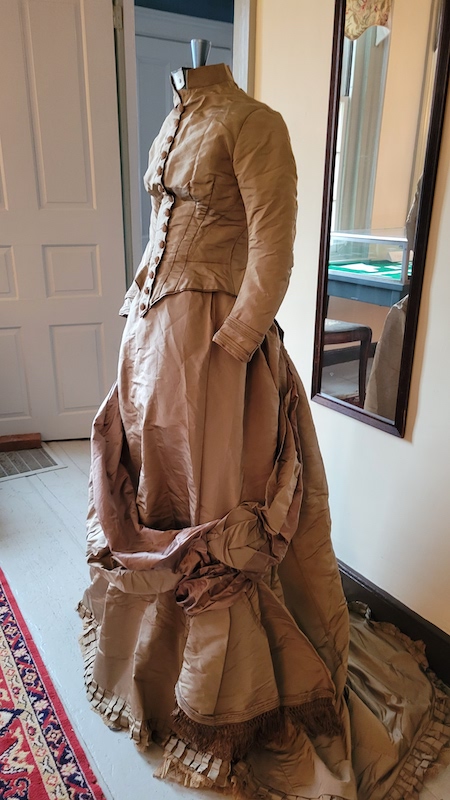
Charlie Breitrose A dress that belonged to a member of the Fowle family is on display during the Historical Society’s celebration of the Fowle House being 251 years old.
The celebration of 251 years of the Fowle House and 100 years of the Historical Society will continue over the next few months.
A special exhibit includes seldom seen historic artifacts, including a dress that belonged to one of the members of the Fowle House.
“It’s been in storage textiles,” Roach said. “You don’t want it out and hanging on a form for too long.”
People can walk around the Council Chamber where the Provincial Congress’ Executive Council met and where the Treaty of Watertown was signed.
Other parts of the exhibition include displays about the timeline of the Historical Society, and one about the history of the Fowle House and its restoration.
“There is a display about how the house was examined by the preservation carpenters who found out all the secrets of how the house was put together and how it got put back together,” Roach said.
Charlie Breitrose
Part of the Historical Society’s display about the history of the Edmund Fowle House, Watertown’s second oldest remaining house. 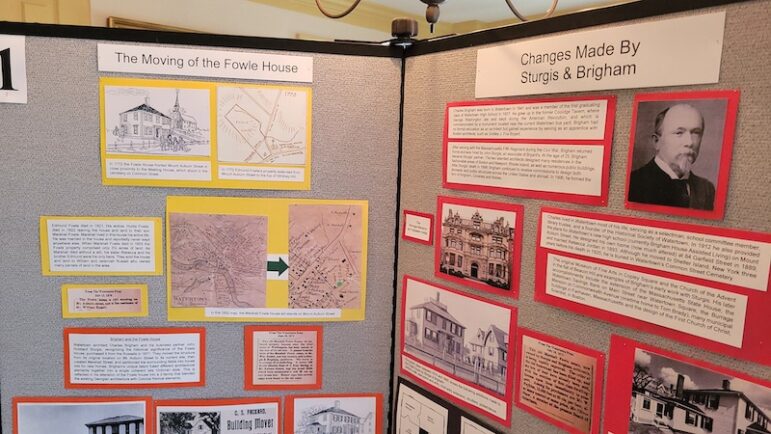
The exhibit will be open several times in May and June:
Weekends from 1-4 p.m.: Saturday, May 20; Sunday, May 28; and Saturday, June 10.
Weekdays from 4:30-6:30 p.m.: Tuesday, May 16; Wednesday, May 24; Wednesday, June 7, and Tuesday, June 20.
The Edmund Fowle House is located at 28 Marshall St., and is open to the public on the third Sunday of the month (it will be closed July and August 2023).
Could you fix the first caption, please? It should say “Declaration of Independence” not “Declaration of Independents”. Thanks.
Thanks for this interesting informative article.
As someone who owned an early 1760’s Gambrel Cape located
in central Massachusetts it is easy to relate to what these old
homes have experienced and retained. Loved the way all the exposed
framing fit together. My cape even had some exposed gunstock timbers.
Best of luck keeping this gem in original condition.